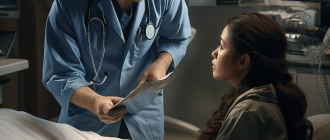 A Comprehensive Guide to Undergoing a Step-By-Step Gallbladder Ultrasound Procedure
A Comprehensive Guide to Undergoing a Step-By-Step Gallbladder Ultrasound Procedure
A gallbladder ultrasound is a non-invasive imaging test that uses high-frequency sound waves to create pictures of the gallbladder. It is commonly performed to assess the gallbladder for various conditions such as gallstones, inflammation, and tumors.
During the procedure, the patient lies on an examination table, and a gel-like substance is applied to the abdomen. The ultrasound technician then uses a small handheld device called a transducer to transmit sound waves through the body. These sound waves bounce off the gallbladder and other nearby structures, creating echoes that are converted into images on a computer screen.
The ultrasound technician will move the transducer over different areas of the abdomen to obtain images from various angles. This allows for a comprehensive evaluation of the gallbladder and surrounding structures. The procedure is painless and typically takes about 30 minutes to complete.
After the gallbladder ultrasound, the images are reviewed by a radiologist who will interpret the findings and provide a report to the referring physician. Depending on the results, further diagnostic tests or treatment may be recommended. Overall, a gallbladder ultrasound is a safe and effective way to assess the health of the gallbladder and aid in the diagnosis of various conditions.
Arriving for the Appointment
When you arrive for your gallbladder ultrasound appointment, it’s important to be prepared and ready to go. Here are some steps to follow:
1. Check-In: Upon arrival, check in at the front desk or registration area. You may be asked to provide your personal information and insurance details.
2. Wait Time: Depending on the clinic’s schedule and the number of patients, there may be a wait time. Bring a book, magazine, or any other form of entertainment to pass the time.
3. Preparation: If you were given any specific instructions by your healthcare provider, make sure to follow them before the appointment. This may include fasting for a certain period of time or avoiding certain foods or medications.
4. Dress Comfortably: Wear loose-fitting and comfortable clothing to allow easy access to your abdomen. You may be asked to change into a hospital gown if necessary.
5. Personal Belongings: Keep your personal belongings secure and organized. You may be asked to remove any metal objects, such as jewelry or belts, before the ultrasound examination.
6. Questions: If you have any questions or concerns, don’t hesitate to ask the healthcare staff. They are there to help and provide you with the necessary information.
7. Relax: It’s normal to feel nervous or anxious before the procedure. Try to relax and breathe deeply. The ultrasound technician will guide you through the process and ensure your comfort.
Follow these steps to ensure a smooth and efficient experience when arriving for your gallbladder ultrasound appointment. Being prepared and informed will help make the process more comfortable for you.
What to Bring With You
When you go for a gallbladder ultrasound, there are a few things you should bring with you to ensure a smooth and successful appointment:
- Your identification documents, such as your driver’s license or passport
- Your health insurance card or information
- A list of any medications you are currently taking
- Any previous medical records or test results related to your gallbladder
- Comfortable clothing that is easy to remove or adjust for the ultrasound procedure
- A bottle of water, as you may be asked to drink water before the ultrasound to fill your bladder and improve visibility
- A book or other form of entertainment to help pass the time while waiting
- A pen and paper to take notes or write down any instructions or recommendations from the healthcare provider
It’s important to be prepared and organized for your gallbladder ultrasound appointment. By bringing these items with you, you can ensure that the process goes smoothly and that you have all the necessary information on hand.
Checking In and Changing Clothes
When you arrive at the ultrasound facility, you will need to check in at the front desk. The receptionist will ask for your name and appointment time to verify your information. They may also ask you to fill out some paperwork or provide insurance information.
Once you have checked in, you will be directed to a changing room. In preparation for the ultrasound, it is important to wear loose-fitting clothing that can be easily removed or pushed up to expose your abdomen. Therefore, you will likely be asked to change into a hospital gown or a provided gown that opens in the front.
If you have any metal objects, such as jewelry or body piercings, it is important to remove them before the ultrasound. Metal can interfere with the ultrasound waves and affect the quality of the images. You may be asked to remove any clothing or accessories that contain metal, such as belts or zippers.
Once you have changed into the appropriate clothing, you can return to the waiting area until your name is called. It is important to arrive at your appointment on time to ensure a smooth and efficient process.
The Ultrasound Procedure
The gallbladder ultrasound procedure is a non-invasive imaging test that uses sound waves to create pictures of the gallbladder. It is typically performed by a radiology technician or sonographer. The procedure usually takes about 30 minutes to complete.
During the ultrasound, the patient lies on an examination table and the technician applies a gel-like substance to the abdomen. This gel helps to transmit the sound waves and improve the quality of the images. The technician then uses a handheld device called a transducer to move over the abdomen, emitting sound waves and capturing the echoes.
The sound waves bounce off the gallbladder and other organs in the area, creating echoes that are converted into images by the ultrasound machine. The images are displayed on a monitor and can be saved for further analysis. The technician may ask the patient to change positions or hold their breath at certain times to get a better view of the gallbladder.
The ultrasound procedure is painless and does not involve any radiation. It is considered safe for people of all ages, including pregnant women. After the procedure, the gel is wiped off and the patient can resume their normal activities. The images are typically reviewed by a radiologist who will interpret the results and provide a report to the patient’s healthcare provider.
Getting into Position
When you arrive for your gallbladder ultrasound, the technologist will ask you to lie down on an examination table. You will typically lie on your back with your abdomen exposed. The technologist may provide a pillow or blanket for your comfort.
It is important to try and relax during the procedure to ensure accurate results. The technologist will provide instructions and guide you through the process. They may ask you to hold your breath or change positions to get better images of your gallbladder.
During the ultrasound, the technologist will apply a clear gel to your abdomen. This gel helps create a smooth surface for the ultrasound probe and enhances the quality of the images. The technologist will then move the ultrasound probe over your abdomen, applying gentle pressure to obtain different views of your gallbladder.
If you are experiencing pain or discomfort during the procedure, it is important to communicate with the technologist. They may be able to adjust your position or technique to alleviate any discomfort.
Overall, getting into the right position and cooperating with the technologist will help ensure a successful gallbladder ultrasound and accurate results.
Using the Transducer
During a gallbladder ultrasound, a transducer is used to produce images of the gallbladder and surrounding organs. The transducer is a small handheld device that sends and receives sound waves. It is placed on the skin and moved around to capture different angles and views of the gallbladder.
Before the procedure begins, a gel is applied to the skin to help the transducer make better contact. The gel also helps to eliminate air pockets that can interfere with the sound waves. The transducer is then gently pressed against the skin and moved in a slow, circular motion. The technician may ask you to take deep breaths or hold your breath for short periods to get clearer images.
The transducer emits high-frequency sound waves that bounce off the gallbladder and surrounding tissues. These sound waves are then converted into images that can be seen on a computer screen. The technician will carefully examine the images to look for any abnormalities or signs of gallbladder disease.
Using the transducer, the technician can also measure the size of the gallbladder and determine if there are any blockages or obstructions in the bile ducts. The procedure is usually painless and takes about 30 minutes to complete.
It is important to follow any instructions given by the technician during the procedure to ensure accurate results. After the ultrasound, the gel will be wiped off and you can resume your normal activities.
The transducer is a key tool used during a gallbladder ultrasound to produce detailed images of the gallbladder and surrounding areas. It is safe, non-invasive, and provides valuable information for diagnosing and monitoring gallbladder conditions.
Following Breathing Instructions
During a gallbladder ultrasound, it is important to follow breathing instructions given by the healthcare provider. These instructions are designed to help obtain clear images of the gallbladder and surrounding structures.
1. Deep Breath: The healthcare provider may ask you to take a deep breath and hold it for a few seconds. This helps to stabilize the position of the gallbladder and reduce movement, allowing for better imaging.
2. Normal Breathing: After holding your breath, the healthcare provider will instruct you to resume normal breathing. It is important to relax and breathe naturally during this time.
3. Exhale: The healthcare provider may then ask you to exhale and hold your breath again. This helps to further stabilize the gallbladder and surrounding structures for clearer images.
4. Repeat as Necessary: The provider may repeat these breathing instructions multiple times during the ultrasound to ensure all angles and areas of the gallbladder are adequately imaged.
5. Follow Additional Instructions: In addition to breathing instructions, the healthcare provider may also ask you to change positions or hold your breath in specific ways to obtain the best possible images.
It is important to follow these breathing instructions carefully to ensure accurate and detailed imaging of the gallbladder. Any movement or improper breathing technique may result in blurry or incomplete images.
After the Ultrasound is Done
After the gallbladder ultrasound is completed, you may be asked to wait while the images are reviewed by a radiologist. The radiologist will analyze the images and look for any abnormalities or signs of gallbladder disease.
If any issues are detected, your healthcare provider will discuss the findings with you and recommend further tests or treatments. They may also provide you with instructions on how to manage your condition or make necessary lifestyle changes.
If the ultrasound results are normal and no abnormalities are found, your healthcare provider may reassure you that your gallbladder is healthy. However, it’s important to note that ultrasound is just one diagnostic tool and additional tests may be needed for a comprehensive evaluation.
Regardless of the results, it’s important to follow up with your healthcare provider and discuss any concerns or questions you may have. They can provide you with the necessary guidance and support to ensure your gallbladder health.
Remember: A gallbladder ultrasound is a non-invasive and painless procedure that allows healthcare providers to assess the health of your gallbladder and surrounding structures. It is an important diagnostic tool in the evaluation of gallbladder diseases and can provide valuable information for treatment and management.
If you have any symptoms or concerns related to your gallbladder, it is essential to consult with a healthcare professional for appropriate evaluation and guidance.
Wiping Off Gel and Getting Dressed
Once the ultrasound technician has completed the examination, they will wipe off the gel from your abdomen and clean the area. You may be provided with a towel or tissue to wipe away any excess gel yourself.
After the gel has been removed, you can get dressed. Make sure to bring comfortable and loose-fitting clothing with you to your ultrasound appointment. This will make it easier for you to put your clothes back on and avoid any discomfort or restriction.
If you are concerned about any residual gel on your skin, you can ask the technician for a towel or tissue to ensure that you are completely clean before getting dressed.
It is important to note that the gel used during the ultrasound is water-based and should not stain your clothing. However, if you notice any gel residue on your clothes, you can simply wash them as you normally would.
Once you are dressed and ready to leave, you can thank the ultrasound technician for their assistance and guidance throughout the procedure.
Asking Questions About Results
After your gallbladder ultrasound, you may have questions about the results. It is important to communicate with your doctor or healthcare provider to fully understand the findings. Here are some questions you may want to ask:
- What did the ultrasound show?
- Are there any abnormalities or signs of disease?
- How does the condition of my gallbladder compare to a healthy gallbladder?
- What are the implications of these findings?
- Do I need any further tests or treatments?
- What can I do to maintain the health of my gallbladder?
- Are there any dietary or lifestyle changes I should make?
- What are the potential risks or complications associated with the findings?
- Is there a need for any follow-up appointments or monitoring?
- Do I need to take any medications?
It is important to have an open and honest discussion with your healthcare provider to ensure that you fully understand the results and the next steps in your care plan. Don’t hesitate to ask any questions or voice any concerns you may have.
Next Steps for Diagnosis
After a gallbladder ultrasound, your doctor will review the images and results to make a diagnosis. Depending on the findings, there may be several next steps for further evaluation.
- Blood tests: Your doctor may order blood tests to check for liver or pancreas issues, as well as to measure certain enzymes and bilirubin levels.
- Additional imaging tests: In some cases, your doctor may recommend further imaging tests, such as a CT scan or an MRI, to get a more detailed look at your gallbladder and surrounding organs.
- Endoscopic retrograde cholangiopancreatography (ERCP): If there are concerns about the bile ducts, your doctor may recommend an ERCP. This procedure uses a long, flexible tube with a camera to examine the bile ducts and remove any blockages or stones.
- Biopsy: In rare cases, if there are suspicions of cancer or other serious conditions, a biopsy may be necessary. This involves taking a small tissue sample from the gallbladder for further analysis.
It is important to follow your doctor’s recommendations for further evaluation and treatment based on the results of your gallbladder ultrasound. Early diagnosis and intervention can help prevent complications and improve your overall health.
Question and answer:
What is a gallbladder ultrasound?
A gallbladder ultrasound is a medical imaging procedure that uses sound waves to produce images of the gallbladder. It is used to diagnose various conditions and diseases of the gallbladder.
Why would someone need a gallbladder ultrasound?
A gallbladder ultrasound may be needed to investigate symptoms such as abdominal pain, jaundice, or abnormal liver function tests. It can help diagnose conditions such as gallstones, inflammation of the gallbladder, or tumors.
How is a gallbladder ultrasound performed?
A gallbladder ultrasound is performed by applying a gel to the abdomen and using a device called a transducer to produce sound waves. The transducer is gently moved over the abdomen to capture images of the gallbladder and surrounding areas.
Is a gallbladder ultrasound painful?
No, a gallbladder ultrasound is a non-invasive and painless procedure. The patient may feel slight pressure or discomfort from the transducer, but it is generally well-tolerated.
What can a gallbladder ultrasound show?
A gallbladder ultrasound can show the size and shape of the gallbladder, the presence of gallstones, thickening of the gallbladder wall, and any abnormalities or tumors. It can also help assess the function of the gallbladder.






